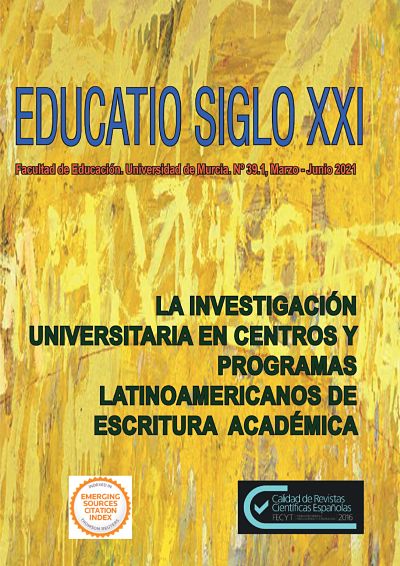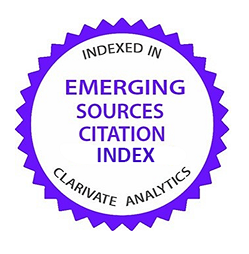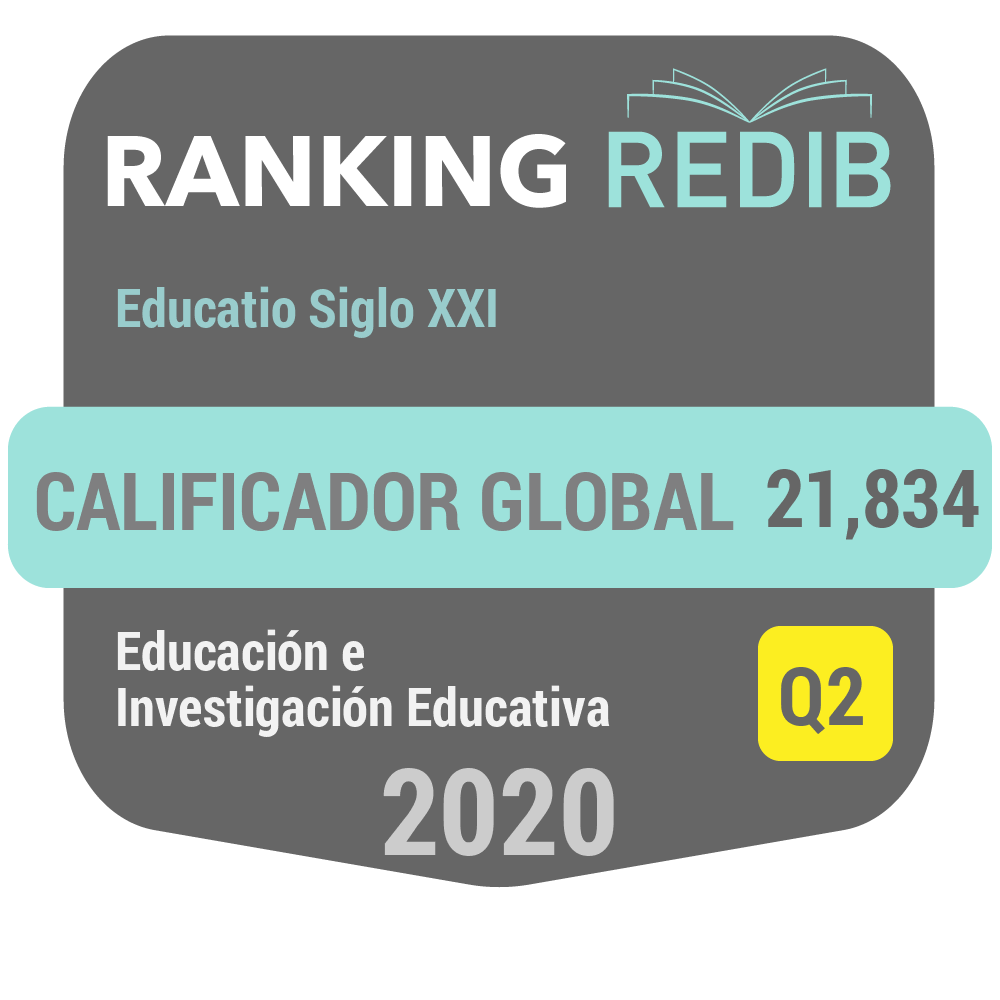Pedagogical, technological and social interaction aspects of mobile learning: A systematic review
Abstract
The use of mobile technologies is increasing exponentially in training contexts as a way to enable dynamic, flexible and open teaching-learning methodologies. This article presents a systematic review carried out considering scientific articles indexed in the Education databases ERIC and Dialnet. We aimed to develop an explanatory model in which elements emerging from mobile learning were identified. Articles were analyzed to configure an explanatory mobile learning model considering three aspects: pedagogical, technological and social interaction. The results show key elements that help to understand the importance of mobile learning in designing a student-centered learning process that addresses the needs of collaboration and interrelationship between users both in social media environments and outside the classroom. It also emphasizes the need for mobile learning to be connected, to be open, flexible, ubiquitous, and implemented through active learning methodologies.
Downloads
References
Adegbija, M. V. & Bola, O. O. (2015). Perception of undergraduates on the adoption of mobile technologies for learning in selected universities in Kwara state , Nigeria. Procedia - Social and Behavioral Sciences, 176, 352–356. http://doi.org/10.1016/j.sbspro.2015.01.482
Alhassan, R. (2016). Mobile Learning as a Method of Ubiquitous Learning: Students’ Attitudes, Readiness, and Possible Barriers to Implementation in Higher Education. Journal of Education and Learning, 5(1), 176–189. http://doi.org/10.5539/jel.v5n1p176
Al-said, K. M. (2015). Students’ Perceptions of Edmodo and Mobile Learning and their Real Barriers towards them. TOJET: The Turkish Online Journal of Educational Technology, 14(2), 167–180.
Althunibat, A. (2015). Determining the factors influencing students’ intention to use m-learning in Jordan higher education. Computers in Human Behavior, 52, 65–71. http://doi.org/10.1016/j.chb.2015.05.046
Antunes, O. & Tenorio, L. R. (2010). Student Perspectives about Mobile Learning Initiatives at Open University of Brazil: The Mobile Phone Issue. Acta Scientiarum. Education, 32(2), 219–223. http://doi.org/10.4025/actascieduc.v32i2.11545
Bahry, F. D. S., Anwar, N., Amran, N., & Rias, R. P. M. (2015). Conceptualizing Security Measures on Mobile Learning for Malaysian Higher Education Institutions. Procedia - Social and Behavioral Sciences, 176, 1083–1088. http://doi.org/10.1016/j.sbspro.2015.01.582
Becerra, M. L. (2015). Desarrollo de competencias ciudadanas: una experiencia desde el m-learning en la formación de antropólogos. Aularia: Revista Digital de Comunicación, 4(2), 23–32.
Brantes, J., Sabino, A., Azevedo, M. L., Campos, H., Calvão, A. M., & Junqueria, C. (2013). Intention to Use M-Learning in Higher Education Settings. Pretexto, 15, 11–28.
Brazuelo, F., & Cacheiro, M. L. (2015). Estudio de adaptabilidad para dispositivos móviles en plataformas MOOC. RED-Revista de Educación a Distancia, 47, 1–13.
Broadbent, J., & Poon, W. L. (2015). Self-regulated learning strategies & academic achievement in online higher education learning environments: A systematic review. Internet and Higher Education, 27, 1–13.
Chen, Q., & Yan, Z. (2016). Does multitasking with mobile phones affect learning? A review. Computers in Human Behavior, 54, 34–42. http://doi.org/10.1016/j.chb.2015.07.047
Cheon, J., Lee, S., Crooks, S. M., & Song, J. (2012). An investigation of mobile learning readiness in higher education based on the theory of planned behavior. Computers & Education, 59(3), 1054–1064. http://doi.org/10.1016/j.compedu.2012.04.015
European Commission (2012). Communication from the Commission to the European Parliament, the Council, the European Economic and Social Committee and the Committee of the regions. Rethinking Education: Investing in skills for better socio-economic outcomes. COM (2012) 669 final.
Fombona, J. & Pascual Mª A. (2013). Beneficios del m-learning en la Educación Superior. Educatio Siglo XXI, 31(2), 211-234.
Gikas, J., & Grant, M. M. (2013). Mobile computing devices in higher education: Student perspectives on learning with cellphones, smartphones & social media. Internet and Higher Education, 19, 18–26. http://doi.org/10.1016/j.iheduc.2013.06.002
Godejord, B. J., González-Pérez, A., Figueiredo, M., & Solmaz, A. (2016) Breaking free of the classroom: implementing digital media to enhance students’ involvement in learning mathematics, ICERI2016 Proceedings, Seville, 14th-16th November, 2016, pp. 4144-4150.
Goh., J.W.P., Quek, C. J., & Lee, O. K. (2010). An Investigation of Students’ Perceptions ofLearning Benefits of Weblogs in an East Asian Context: A Rasch Analysis. Educational Technology & Society, 13(2), 90-101.
Gómez, P., & Monge, C. (2013). Potencialidades del teléfono móvil como recurso innovador en el aula: una revisión teórica. Didáctica, Innovación Y Multimedia, 9(26), 1–16.
Gómez, E., Fernando, D., Aponte, G., & Betancourt, L. A. (2014). Metodología para la revisión bibliográfica y la gestión de información de temas científicos, a través de su estructuración y sistematización. DYNA, 81(184), 158-163.
González-Pérez, A. (2019). Marco pedagógico que sustenta el diseño de la aplicación MILAGE Aprender+ para aprender matemáticas en las escuelas secundarias. En F.I. Revuelta & I. Pedrera (Ed), Retos y evidencias en la investigación con videojuegos en educación (pp. 117-128). Barcelona: Octaedro.
Guirao, J. A., Olmedo, A., & Ferrer, E. (2008). El artículo de revisión. Revista Ibero-Americana de Enfermería Comunitaria, 1(6), 1–25.
Hsu, S. H., Chang, J. W., & Lee, C. C. (2013). Designing attractive gamification features for collaborative storytelling websites. Cyberpsychology, Behavior, and Social Networking, 16(6), 428-435.
Joan, R. R. (2013). Research papers a study on mobile learning as a learning style. I-Manager´s Journal on School Technology, 8(4), 29–37.
Kitchenham, B. (2004). Procedures for Performing Systematic Reviews. UK and Autralia: Joint Technical Report. Retrieved from http://www.inf.ufsc.br/~aldo.vw/kitchenham.pdf
Kong, S. C. & Song, Y. (2015). An Experience of Personalized Learning Hub Initiative Embedding BYOD for Reflective Engagement in Higher Education. Computers & Education, 88, 227–240. http://doi.org/10.1016/j.compedu.2015.06.003
Koole, M. L. (2009) ‘A Model for Framing Mobile Learning’, in Ally, Mohamed. (ed.), Mobile Learning: Transforming the Delivery of Education and Training, (pp. 25-50), Athabasca University, Canada: Edmonton.
Laine, E., Veermans, M., Lahti, A., & Veermans, K. (2017). Generation of Student Interest in an Inquiry-Based Mobile Learning Environment. Frontline Learning Research, 5(4), 42-60. https://doi.org/10.14786/flr.v5i4.306
Mishra, P., & Koehler, M. J. (2006). Technological pedagogical content knowledge: A framework for teacher knowledge. The Teachers College Record, 108(6), 1017–1054.
Nakano, T., Mija, A., Begazo, J., Garret, P., Velasco, A., & Rosales, A. M. (2013). Uso de tablets en la Educación superior: una experiencia con iPads. Digital Education Review, 24, 135–161.
Organista, J., & Serrano, A. (2011). Implementación de una actividad educativa en modo colaborativo con apoyo de smarthpones: una experiencia universitaria. EDUTEC: Revista Electrónica de Tecnología Educativa, 36, 1–19.
Rannu, R., Saksing, S., & Mahlakõiv, T. (2010). Mobile government: 2010 and beyond. White paper, Mobi Solutions Ltd.
Reychav, I. & Wu, D. (2015). Mobile collaborative learning: The role of individual learning in groups through text and video content delivery in tablets. Computers in Human Behavior, 50, 520–534. http://doi.org/10.1016/j.chb.2015.04.019
Sarrab, M.; Elbasir, M., & Alnaeli, S. (2016). Towards a quality model of technical aspects for mobile learning services : An empirical investigation. Computers in Human Behavior, 55, 100–112. http://doi.org/10.1016/j.chb.2015.09.003
Somoano, Y. & Menéndez, J. I. (2018). Percepciones de alumnado y profesorado sobre una intervención de mobile learning en Inglés como Lengua Extranjera. Innoeduca: international journal of technology and educational innovation, 4(1), 79-87. http://doi.org/10.24310/innoeduca.2018.v4i1.3024
Soykan, E., & Uzunboylu, H. (2015). The review of published articles on mobile learning area in EBSCO database. Procedia - Social and Behavioral Sciences, 182, 710–717. http://doi.org/10.1016/j.sbspro.2015.04.818
Su, C. H., & Cheng, C. H. (2013). A mobile game-based insect learning system for improving the learning. Procedia - Social and Behavioral Sciences, 103, 42–50. http://doi.org/10.1016/j.sbspro.2013.10.305
Suárez, R., Crescenzi, L., & Grané, M. (2013). Análisis del entorno colaborativo creado para una experiencia de mobile learning. Education in the Knowledge Society (EKS), 14(1), 101–122.
Tabuenca, B., Kalz, M., Drachsler, H., & Specht, M. (2015). Time will tell: The role of mobile learning analytics in self-regulated learning. Computers & Education, 89, 53–74. http://doi.org/10.1016/j.compedu.2015.08.004
Tedesco, J. C. (2000). Educar en la sociedad del conocimiento. Buenos Aires: Fondo de Cultura Económica de Argentina.
Wang, C. H., Shannon, D., & Ross, M. (2013). Students' characteristics, self-regulated learning, technology self-efficacy, and course outcomes in online learning. Distance Education, 34, 3, 302–323. https://doi.org/10.1080/01587919.2013.835779
Yot, C. & Marcelo, C. (2015). ¿Despega el M-Learning? Análisis de la disposición y hábitos de los usuarios. Pixel-Bit. Revista de Medios y Educación, 46, 205–218. http://doi.org/http://dx.doi.org/10.12795/pixelbit.2015.i46.13
Zaheer, S., Butt, S. M., Anatolyevna, G. V., & Salmani, H. (2018). Do Mobile Technology in the Classroom Really Improve Learning Outcomes?. International Journal of Evaluation and Research in Education, 7(3), 188-193. https://doi.org/10.11591/ijere.v7.i3.pp188-193

This work is licensed under a Creative Commons Attribution-NonCommercial-NoDerivatives 4.0 International License.
Original work publishes in this journal is subject to the following terms:
1. Murcia University Press (the publishing house) holds the copyright of the publishes work, and favours and allows their reutilization under the use license stated in point 2.
© Servicio de Publicaciones, Universidad de Murcia, 2015
2. Work is published in the electronic edition under a license (Creative Commons Reconocimiento-NoComercial-SinObraDerivada 4.0 España (legal text). They can be copied, used, disseminated, transmitted and publicly presented, as long as: i) authorship and original publication source is acknowledged (journal, publishing house and URL of the work); ii) are not used for commercial purposes; iii) the existence and specifications of this use license is stated.
3. Conditions for self-archive. Authors are allowed and encouraged to disseminate electronically the pre-pint (before review) and/or post-print (accepted for publication) versions of their work before their publication since that favours earlier circulation and dissemination resulting in an increased chance for the authors to be cited and for the work to reach a bigger share of the academic community. Colour: RoMEO: green.








